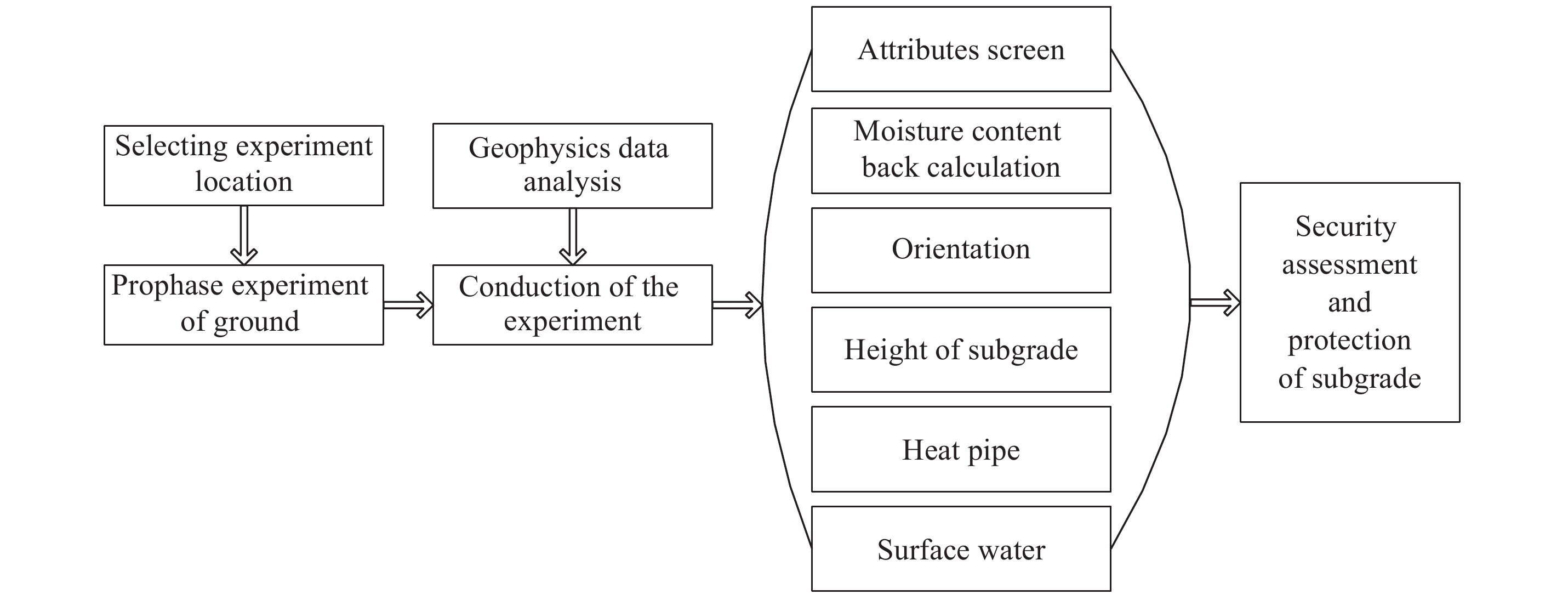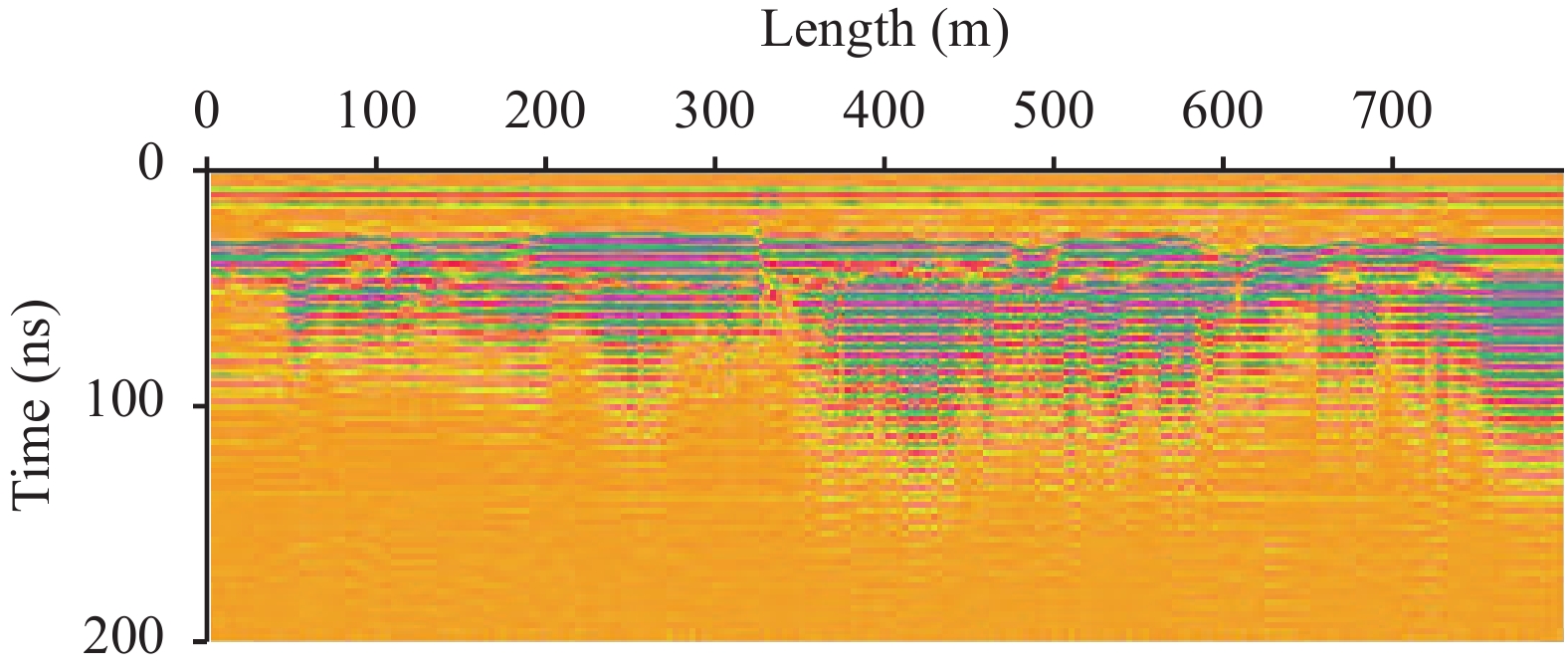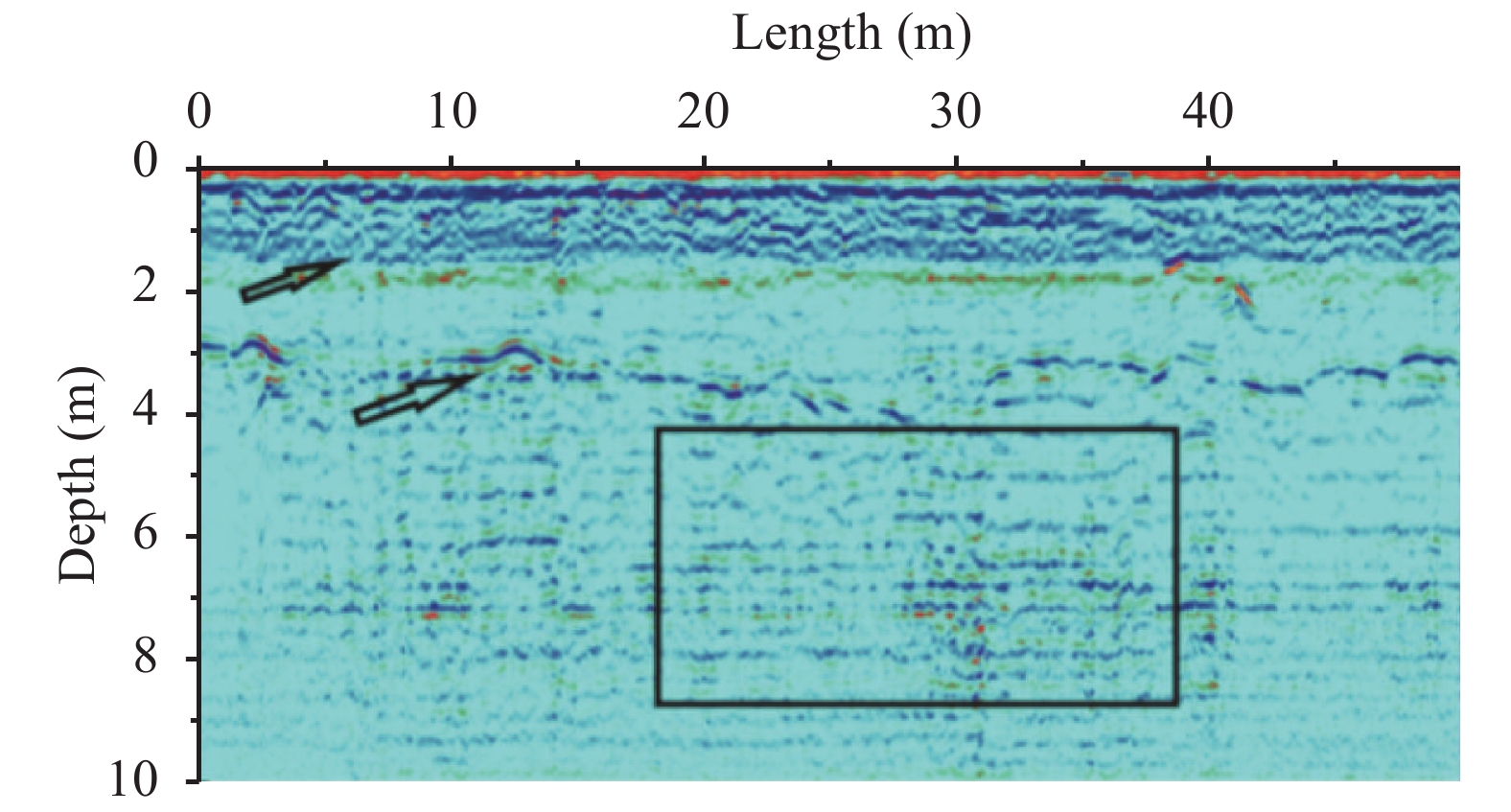Article Information
- ZhiChun Zhang, YuPeng Shen, Xiao Wang, YaHu Tian, JianKun Liu, Bagdat Teltayev . 2017.
- Using attributes of electromagnetic waves to determine the water content and frost table in a permafrost area
- Sciences in Cold and Arid Regions, 9(3): 261-266
- http://dx.doi.org/10.3724/SP.J.1226.2017.00261
Article History
- Received: November 21, 2016
- Accepted: December 21, 2016
2. School of Civil Engineering, Beijing Jiaotong University, Beijing 100044, China;
3. Kazakhstan Highway Research Institute, Almata, Kazakhstan
Permafrost is a significant feature of the Tibetan Plateau (TP) and is attributed to the cold climate. During the construction or operation period of the railway or highway line engineering in permafrost areas, there are many changes—such as topography, vegetation, surface reflection, permeability, snow cover, and surface-water redistribution—that can break the thermal equilibrium between the permafrost and the atmosphere, increasing detrimental heat, recession of the permafrost, acceleration of the thawing speed of the active layers (Treat et al., 2013 ). Under the combined effects of global climate and human activities, the engineering problems intend to take place when the environment has been changed in permafrost areas for nearly 40 years (Zhang et al., 2015 ). The bearing capacity would reduce, and excessive settlement would occur due to the recession or thawing of the permafrost, where slope instability and surface cracks would appear simultaneously (Jiang et al., 2014 ; Niu et al., 2014 ). Thawing of the seasonal permafrost can lead to changes in the electromagnetic properties of the materials in the thawing zone, which would be reflected in the signals of wave fields in the geophysical field (Davis and Annan, 1989). Some researchers have tried to use the geological penetrating radar (GPR) data to study the permafrost thawing (Steelman and Anthony, 2009).
Ground-penetrating radar (GPR) is a noninvasive and efficient geophysical method for imaging and characterizing shallow subsurface targets (Zhao et al., 2013 ); it is widely applied in many fields, such as geotechnical engineering, archaeological prospection, pipeline location, and geological studies.
To obtain more information from GPR data, GPR attributes are used to analyze and interpret GPR data (Bradford et al., 2010 ). The attributes of GPR are similar to seismic attributes because they can be subjected to the same wave theory (Ursin, 1983), processing methods, and interpretation techniques (Baker et al., 2001 ). Attributes, based on seismic or GPR data such as polarity, phase, frequency, or velocity, are a quantitative measure of a geophysical characteristic of interest (Chopra and Marfurt, 2005). The information that might be more subtle in a traditional data image can be enhanced through analyzing the attributes, leading to a better geological or geophysical qualitative and quantitative interpretation of the data (Chopra and Marfurt, 2006). However, there are hundreds of types of GPR attributes from geometrical and physical features. The sensitive and appropriate attributes need to be screened for different target detection and detection purposes. More recently, Zhao et al. (2013) used the GPR attribute-analysis method for archaeological prospecting in the river harbor area of the Aquileia Archaeological Park in northeast Italy. They calculated and critically evaluated several attributes to characterize the target in 2D and 3D volume. In the western portion of the Potiguar Basin (northeastern Brazil), João et al. (2014) used selected GPR attributes to identify and delineate subsurface collapsed paleocave systems. Amir et al. (2013) used GPR attenuation attributes to monitor and assess a bridge deck.
GPR was recently applied to image the near-surface thermal structure and profiles of permafrost because of its strong dielectric permittivity contrasts between frozen and unfrozen wet materials (Hinkel et al., 2001 ; Moorman et al., 2003 ). Even though it is important to obtain the properties of the permafrost thawing medium and information about the permafrost treatment project by using GPR attributes, the results are relatively limited to research the method of using the GPR data attributes characterizing properties of the permafrost thawing medium and evaluate the impact of different factors on permafrost thawing.
Furthermore, a key aspect to estimate quickly the water content because engineers use it to predict and detect roadbed stability and hazardous locations. Due to the limitations of low efficiency and relative expense of sample measurement, some researchers propose methods to estimate water content by using GPR data. These methods are based on the direct ground wave and Rayleigh scattering of GPR. However, it is difficult to obtain these kinds of data in the Qinghai-Tibet Plateau because the survey acquisition mode for CMP (common middle point) gather is time-consuming and laborious. How to quickly estimate the water content from a self-excited and self-closing (zero offset) GPR profile is a pivotal problem waiting to be solved.
To solve these problems, we designed a series of GPR experiments on the Qinghai-Tibet highway, which is close to the Chumaer River, in the central part of the Tibetan Plateau. Through various calculations, a set of types of GPR attributes and parameters was obtained that may be effectively used in characterizing the permafrost: such as amplitude, phase, frequency, and velocity. This research provides a direct and effective method of utilizing GPR attributes to characterize the permafrost thawing and evaluate the impacts of key factors on that thawing. Besides, it also provides a rapid algorithm for relative water-content evolution by using GPR data.
2 General situation of sampling at the locationWe arranged a survey grid and gathered ground-penetrating radar data at three spots encountering subgrade settlement. Table 1 shows the specificities of the experiment, and Figure 1 shows the location of the site.
| Location | Type of record | Number of data | Sampling rate |
| K2968+200 | 2D, CMP | 25 strips/1,000 m | 200/80/40 MHz |
| K3015+750 | 2D | 12 strips/300 m | 200/80 MHz |
| K3181+100 | 2D/3D | 11 strips/200 m | 200 MHz |

|
| Figure 1 Survey at the location |
The monitoring focused on the feasibility of using ground-penetrating radar to scan the Tibetan Plateau permafrost soil. The parameter experiment and feasibility research were mainly about the frequency setting, area of the sampling sites, and energy amplifying in order to decide how to conduct the further experiment on a larger area. Then we studied the characteristics of thawing and development of the permafrost soil under different circumstances. The technical route is shown in Figure 2.

|
| Figure 2 Technical route |
Then several effective attributes of melting permafrost soil were examined, and methods of back-calculation of moisture content were applied, working effectively on the identification and assessment of the development of melting permafrost soil.
(1) Weighing average transient frequency
The mathematical definition of transient frequency is the differential of the signal phase
| $z(t) = \sum\limits_{n = 0}^{ + \infty } {{a_n}} (t){{\rm e}^{j{\varphi _n}(t)}} = a(t){{\rm e}^{j\varphi (t)}}$ | (1) |
In the formula, an(t) is a constant. However, transient frequency easily induces peaks and noise that can confuse the authentic microspecificities, which is not good for exposing the characteristics of the thin layers of permafrost soil. It appeared to be nonsensical to use transient frequency for explaining. To overcome this defect, the weighted average frequency is imported, which is defined as follows by using signal z(t):
| $\varpi (t) = \sum\limits_{n = 0}^{ + \infty } {a_n^2(t)\phi _n'(t)} /\sum\limits_{n = 0}^{ + \infty } {a_n^2(t)} $ | (2) |
Weighing average frequency generally is not affected by the short waves and can effectively reflect the physical properties of the medium affecting the development of melting.
(2) Desert properties
Mathematically, desert properties are the root-mean-square of the division of reflection strength and transient frequency, in which the reflection strength is the transient amplitude and envelope of amplitude.
| $s(t) = \sqrt {x_r^2 + x_i^2/a(t){{\rm e}^{j\varphi (t)}}} $ | (3) |
Desert properties have advantages in distinguishing sandstone and mudstone. When the permafrost soil melts, the change in volume of the holes in the medium with ice is magnificent; asymmetrically, individual strong reflection points come into being, as well as micro-holes and a crack system in the melting zone.

|
| Figure 3 Display of attributes of the amplitude |

|
| Figure 4 Relative wave impedance |

|
| Figure 5 Back-calculation of moisture content |

|
| Figure 6 Profile of the properties of the amplitude |

|
| Figure 7 Profile of the desert properties |
When the location of GPR remained external, the amplitude boosts were apparent in the thermokarst zone, whose underground medium was altered by a large margin. Amplitude attributes, weighing average frequency spectrum, and the desert properties show that a water-ice mixture zone and half-melted zone were generated under the upper boundary of the permafrost soil, with the depth influenced having positive correlation to the surface water. The dark ice-water mixture interface is well displayed by the weighing average frequency (Figure 3).
It could be easy to explicitly image stratified physical properties of an underground medium through the back-calculation of relative wave impedance. The black arrows in Figure 4 explicate not only the interface of the subgrade and the initial road surface but also the remarkable frontal of the melting frost soil. The inner interface of the frozen soil melting in the developing zone of thermokarst appears to collapse; the reflection strength of the stratified wave impedance is high and has floated on the interface; the wave impedance of the whole reflection interface becomes low; symmetrically, the zone in the thermokarst develops deeper than 7 m. Figure 5 shows the distribution profile of the relative moisture content, which shows that the relative moisture content is greater than the layers above the remarkable melting interface and the thermokarst developing zone.
4.2 Electromagnetic properties under heat pipe processFigure 6 is the analysis results of the working sketch of the protection of the heat pipe to the subgrade detected by ground-penetrating radar, which can figure out that the layers of the side of the frost soil without the heat pipe are corresponding and clear, while the frost-melted interface of the other side with a heat pipe varies complexly on the contrary; yet the average depth of both is the same. Heat pipes appear to have a negative effect on the melting of the soil under the sunny slope. The red arrows show the effect of the heat pipe to the radar profile. Weighing average frequency properties show the depths of the melting frontal surface are basically corresponding to the surface of the sunny slope or the opposite surface. The white arrows show the fully melting frozen soil of the surface of the sunny slope, which has greater effect on the lower ice layers.
Figure 7 is the desert properties of the cross section, highlighting the melting specificities of the side of the subgrade with heat pipes. Because the heat from the sun is conducted into the inner zone, heat pipes carry the heat from the inner zone to the outside; this artificial alternative conducts the heat, causing the differences in the melting status, although the average melting depth of both sides are approximately the same; and the melting of the side with heat pipes is stronger, the concentration of moisture having a larger effect on the ice layer of the melting interface.
The profile of the relative wave-impedance properties shows the complexity and fierceness of the inner impedance under the effect of the moisture and the degree of melting beneath the yearly stable melting surface. The yellow arrow shows the melting wave-impedance feature at the location of each heat pipes.
5 Conclusions(1) The method of using ground-penetrating radar can effectively identify and analyze the development of the frozen soil; and frequencies of the radar vary as 200 MHz, 80 MHz, and 40 MHz according to the depths. The largest melting interface of the survey on the Tibet Plateau was 2.5~3 m, fitted for the sampling via using antenna of 200 MHz.
(2) The heat pipe can effectively prevent the thawing of frozen soil in the deep zone, the grid of which on the sunny slope should be closer in the zone where rainfall can be gathered easily.
(3) The development feature of the melting of the frozen soil can be effectively analyzed by studying the weighing average frequency and two electromagnetic properties of the desert properties of ground-penetrating radar. Also, the water-distribution features in the detected zone could be better imaged by using the relation formula between electromagnetic wave properties and the moisture content of the frozen soil.
Acknowledgments:This work was supported by the Fundamental Research Funds for the Central Universities (2015JBM064), the 49th Project Sponsored by the Scientific Research Foundation for the Returned Overseas Chinese Scholars infrastructure in State Education Ministry, and the research project entitled "The freezing injury evaluation of subgrade and remediation technology research in Shenchi-Shuozhou Railway" (No. 2015-10), whose support is acknowledged.
| Achim H, Olaf E, Martin S, 2010. Temporal observations of a seasonal snowpack using upward-looking GPR. Hydrological Processes, 24(22): 3133–3145. DOI: 10.1002/hyp.7749 |
| Ali IK, Gabor T, Peter N, et al, 2015. GPR survey for reinforcement of historical heritage construction at fire tower of Sopron. Journal of Applied Geophysics, 112: 79–90. DOI: 10.1016/j.jappgeo.2014.11.005 |
| Amir M, Alania B, Morteza A, et al, 2013. Applications of ground penetrating radar (GPR) in bridge deck monitoring and assessment. Journal of Applied Geophysics, 97: 45–54. DOI: 10.1016/j.jappgeo.04.009 |
| Andrea B, 2010. Water content evaluation in unsaturated soil using GPR signal analysis in the frequency domain. Journal of Applied Geophysics, 71(1): 26–35. DOI: 10.1016/j.jappgeo.2010.03.001 |
| Baker GS, Steeples DW, Schmeissner C, et al, 2001. Near-surface imaging using coincident seismic and GPR data. Geophysical Research Letters, 28(4): 627–630. DOI: 10.1029/2000GL008538 |
| Bradford JH, Dickins DF, Brandvik PJ, 2010. Assessing the potential to detect oil spills in and under snow using airborne ground-penetrating radar. Geophysics, 75(2): G1–G12. DOI: 10.1190/1.3312184 |
| Chopra S, Marfurt KJ, 2005. Seismic attributes–a historical perspective. Geophysics, 70(5): 3SO–28SO. DOI: 10.1190/1.2098670 |
| Chopra S, Marfurt KJ, 2006. Seismic attributes–a promising aid for geological prediction. CSEG Recorder 2006 Special Edition, pp. 115–126. |
| Davis JL, Annan AP, 1989. Ground penetrating radar for high resolution mapping of soil and rock stratigraphy. Geophysical Prospecting, 37: 531–551. DOI: 10.1111/j.1365-2478.1989.tb02221.x |
| Hinkel KM, Doolittle JA, Bockheim JG, et al, 2001. Detection of subsurface permafrost features with ground-penetrating radar, Barrow, Alaska. Permafrost and Periglacial Processes, 12(2): 179–190. DOI: 10.1002/ppp.369 |
| Jiang H, Shan W, Hu ZG, et al, 2014. Formation mechanism and deformation characteristics of cut layer rock landslide in island permafrost region. Landslide Science for A Safer Geoenvironment, 3: 471–480. DOI: 10.1007/978-3-319-04996-0_72 |
| João ADRJ, David LDC, Thales ESDJ, et al, 2014. Characterization of collapsed paleocave systems using GPR attributes. Journal of Applied Geophysics, 103: 43–56. DOI: 10.1016/j.jappgeo.2014.01.007 |
| Moorman BJ, Robinson SD, Burgess MM, 2003. Imaging periglacial conditions with ground-penetrating radar. Permafrost and Periglacial Processes, 14(4): 319–329. DOI: 10.1002/ppp.463 |
| Niu FJ, Luo J, Lin ZJ, et al, 2014. Thaw-induced slope failures and susceptibility mapping in permafrost regions of the Qinghai-Tibet Engineering Corridor, China. Natural Hazards, 74(3): 1667–1682. DOI: 10.1007/s11069-014-1267-4 |
| Steelman CM, Anthony LE, 2009. Evolution of high-frequency ground-penetrating radar direct ground wave propagation during thin frozen soil layer development. Cold Regions Science and Technology, 57(2): 116–122. DOI: 10.1016/j.coldregions.2009.01.007 |
| Treat DC, Wisser SM, Frolking S, 2013. Modelling the effects of climate change and disturbance on permafrost stability in northern organic soils. Mires and Peat, 12: 1–17. |
| Ursin B, 1983. Review of elastic and electromagnetic wave propagation in horizontally layered media. Geophysics, 48(1): 1063–1081. DOI: 10.1190/1.1441529 |
| Zhang MY, Pei WS, Zhang XY, et al, 2015. Lateral thermal disturbance of embankments in the permafrost regions of the Qinghai-Tibet Engineering Corridor. Natural Hazards, 78(3): 2121–2142. DOI: 10.1007/s11069-015-1823-6 |
| Zhao WK, Forte E, Pipan M, et al, 2013. Ground Penetrating Radar (GPR) attribute analysis for archaeological prospection. Journal of Applied Geophysics, 97: 107–117. DOI: 10.1016/j.jappgeo.2013.04.010 |
 2017, 9
2017, 9


